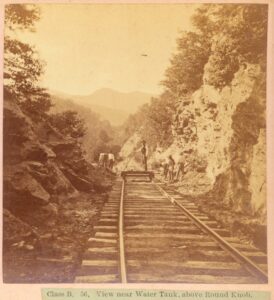
Through Rock and Time:
The Railroad Comes to the Mountains
by Trevor Freeman
“The railroad they were to build was to scale the lower part of the mountain, turning and twisting about…until it reached Swannanoa Gap, which was…the historic entryway into the mountain country, had served as such since the first settlers went up there about a hundred years earlier.”
– John Ehle, The Road
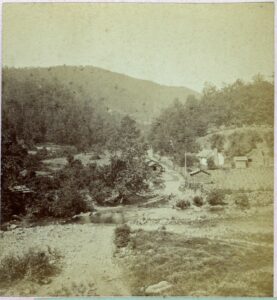
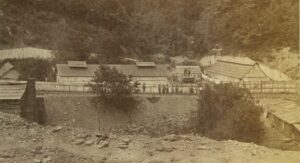
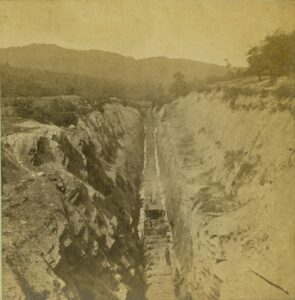
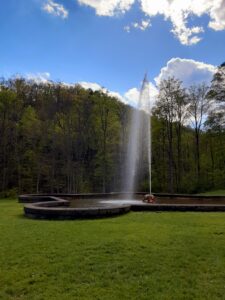
For natives and later interlopers alike, our region has long posed challenges to transportation. Accompanying Hernando De Soto’s marauding 1557 trek into what is now western North Carolina, the Portuguese Gentleman of Elvas described the Blue Ridge as “montanhas muito acidentadas e elevadas” or very rough and lofty mountains. These Europeans presumably struggled to cross a precipitous mountain gap near modern Saluda on their way to an Indian settlement near present Asheville. The Cherokee had long prior told tales of little people and other barriers in the Hickory Nut Gorge blocking their access to the Catawba people and trading partners to the east. The few high mountain gaps provided vital routes through the imposing Blue Ridge Escarpment separating the flatter interior plateau of the Appalachians from the rolling foothills and piedmont to the east, while narrow creeks and shallow river valleys or gorges served as the other available avenues for mountain residents and explorers. The routes of natives were ironically used against them by intruding whites, such as during Gen. Griffith Rutherford’s proto-genocidal expedition against the Cherokee in late 1776; entering the mountains through the Swannanoa Gap, they followed the namesake river west toward Cherokee villages they soon destroyed.
These gaps—the Saluda and Swannanoa, and to a lesser extent the Hickory Nut—were adequate for pre-capitalistic peoples living and trading simply with outside nations. But as white European descendants and the enslaved people they sometimes brought with them entered the mountains and displaced the Cherokee, their ability to partake in a larger market economy was significantly thwarted by logistical and transportation barriers. North Carolina’s relative lack of eastward-flowing navigable rivers meant that most goods produced west of the line of Piedmont waterfalls were transported to South Carolina or even Virginia to be sold and shipped. In 1856, the engineer of the Western North Carolina Railroad described the state as a “vassal” to its neighbors. The western part of the state, already at a disadvantage because of its remoteness, relied heavily on the French Broad River corridor to transport goods along a Greenville, SC to Greeneville, TN turnpike in the mid-1820s. Thousands of pigs, turkeys, and other animals were driven along Buncombe Turnpike in the decades before the Civil War, and they were joined by additional livestock from the foothills, arriving via a sinuous road in the Hickory Nut Gap. By the 1840s, state-sponsored and locally constructed stagecoach routes provided travelers from South Carolina, Rutherfordton, and Morganton access to the interior of western North Carolina through the Saluda, Hickory Nut, and Swannanoa gaps respectively.
The hair-raising journeys through these rutted and winding roads are described in several interesting traveler accounts. Henry Colton wrote in 1859 of travelling through the Hickory Nut Gap, “The road, for eight miles, winds upon the banks of the Broad River, the contortions of whose troubled waters are beyond description.” Interestingly, he described the stagecoach journey over the Swannanoa Gap as “pleasant.” Regardless of the gap or route taken however, the journey proved difficult enough to restrict the number of travelers, traders, or would-be lowland tourists to a moderate level, and confined the latter to small communities in the Flat Rock and Highlands regions. Amid the antebellum period of state and national infrastructure and internal improvements—championed by Whig party politicians—rudimentary transportation routes began to connect portions of North Carolina to neighboring states. The first rough bridges and planked roadways, constructed and engineered by locals, improved transportation for wagons and foot traffic on the Buncombe Turnpike to a degree. Yet without well-maintained or adequately-designed roads, by and large, the commodities produced or grown in the mountains were largely not enjoyed by eastern North Carolinians, and vice versa. It was clear to many opportunists, politicians, and hopeful farmers that the promising technologies of railroads and steam-powered trains were the necessary means of connecting western North Carolina.
In 1855, North Carolina granted a charter to the Western North Carolina Railroad Company which was to construct a rail line from Statesville to a point along the French Broad River west of the Blue Ridge. Three years prior, South Carolina had chartered their own Blue Ridge Railroad, with plans to link Charleston to Cincinnati and the Midwest by crossing the Blue Ridge. Building a railroad, which by its nature demanded a relatively smooth and low grade, presented several challenges when both rail lines met the mountains. This frequently meant moving large volumes of fill dirt, but also necessitated tunneling through many impassible slopes. In South Carolina, work on the railroad met a dead end 1,600 feet into solid granite in the Stumphouse Tunnel that Irish and enslaved Black laborers were digging by hand. North Carolina’s efforts likewise derailed a few years into the American Civil War with the rail line reaching only Morganton in the foothills. It was clear better financial backing, newer technology, and more labor was needed to traverse the Appalachians.
After years of neglect and destruction during the Civil War, the Western North Carolina Railroad regained bi-partisan momentum. The goals of the railroad had grown over time, and by 1868, two separate divisions of the organization were operating. The Eastern Division—which included the Mountain Division subunit—was responsible for the most arduous project in connecting Statesville to Asheville through the existing corridor and over the Swannanoa Gap. Meanwhile, the Western Division was to construct two spurs from Asheville: one following the French Broad River and old Buncombe Turnpike north to Paint Rock on the Tennessee border, and the other running west through Waynesville and on to Murphy in the far west. Workers soon stretched the tracks to Old Fort at the foot of the Blue Ridge before political fighting and a lack of capital stopped progress for the majority of the 1870s. Finally in 1877, when Buncombe County native Zebulon Vance became governor, he promised in his inauguration speech to make full use of state convicts from the North Carolina Central Prison in Raleigh, sending them to Old Fort to resume the work on the publicly-chartered railroad. They were to join the handful of incarcerated laborers on the mountain who arrived in late 1875.
During the Civil War, Asheville lawyer Nicholas Woodfin had proposed hiring enslaved laborers to rapidly complete the stunted rail line. After the war, however, this source of labor was gone—in de jure terms at least. The Thirteenth Amendment, passed in the aftermath of the Civil War, barred slavery or forced servitude with one exception; those convicted of crimes were liable to find themselves forced to toil, and they often did so on chain labor gangs in the South. This labor was overwhelmingly comprised of African Americans; the 1880s census showed some 85 percent of prisoners in the NC penitentiary were Black. The use of incarcerated laborers for civil infrastructure projects was common throughout the South by this point, and many reform-minded leaders publicly touted this system as a way to make productive use and improve the character of morally deficient criminals as they saw them—not to mention to save the states a great deal of money. An 1876 legislative committee report noted the financial cost of “keeping these creatures” was less on the railroad than in the prison in Raleigh. In North Carolina, this practice persisted nearly into the mid-1900s as prisoners toiled building ever-expanding roads and rails. Their labor underpinned much of the growth and prosperity in the “New South.”
For many incarcerated African Americans, guilt was doubtful or patently false, while many were imprisoned for trumped-up or exaggerated charges as well. Still more were also disproportionately sentenced to hard labor for minor crimes. This is seen in the Wilmington Daily Review of October 14, 1879, which noted sardonically that several men were “Off for Raleigh but not for the fair” for simple larceny, sentenced to several years in the penitentiary. They included identified Black Western North Carolina Railroad laborers Daniel Richardson, Charles Harper, Daniel Brown, and Gould Foy. The trivial nature of their offenses was indicated by another man in the article, Irving Washington, who was sentenced to 90 days labor for the theft of a newspaper. These cases likely typified many of those forced to toil or worked to death as a free source of labor.
Historian Gordon McKinney has noted that Governor Vance, while aware of the mounting deaths and physical toll exacted on these incarcerated laborers supervised by the state or by the private railroad company, never took responsibility and typically insisted work progress more quickly. The desires of Vance and railroad stockholders meant a steady supply of these predominantly Black, eastern North Carolina convicts were forced to dig, haul, blast, and fill as the railroad climbed and burrowed through the Swannanoa Gap. Prisoners grew in number from just over 300 in 1875, to a peak of 1,500 men and several boys laboring at peak capacity before the section was completed. They included many prisoners transferred from similarly brutal work on the Spartanburg & Asheville Railway which struggled to traverse the Saluda Gap and had failed to pay the state for leasing laborers in 1877. A handful of women, mostly used as cooks and laundresses, were also imprisoned and sent to Swannanoa.
The incarcerated laborers were eventually divided into five separate camps: Tomahawk, which was four miles west of modern Ridgecrest, above the Swannanoa Gap, in a middle section near Lick Log Tunnel, at Jarrett’s Tunnel near the Mud Cut, and the lowest of them lived at Round Knob near Andrew’s Geyser outside Old Fort. The first laborers slept in locked boxcars until they built the first of the permanent stockades at Round Knob. They rose early six, sometimes seven, days a week to toil chained together under the watch of white and occasionally Black guards or overseers. Locals, such as the young Arthur “Rattlesnake” Robinson, also watched the laborers and noted the courage they displayed in the face of intractable dangers. They dug with hand implements, in “want of proper and sufficient tools, mules, carts.” Investigators in 1879 described seeing ten men pushing and pulling a cart, “the work of one mule,” because of a lack of funding. They often watched as mud and rock slid back into large cuts they had dug through the mountainsides. They also packed volatile nitroglycerin and sawdust charges into bore holes when blasting tunnels. Their treatment worsened by conflicts in management between prison and railroad officials.
The incarcerated laborers were fed on seven cents per day—a measly diet of cornbread and beans—though Sundays occasionally gave them rest and the inclusion of biscuits and vegetables such as cabbage. Some prisoners did indeed complete their terms of labor and were released but many were seriously weakened or killed in accidents, and an unknown number escaped or died trying. Nine would-be escapees were killed in one instance alone in April, 1877 by a guard in the middle stockade, while fourteen others were wounded. Disease and cave-ins were also frequent killers. An 1879 report denoted thirteen men killed by guards, accident, or fellow prisoners, while forty-three succumbed to sickness. The deceased were unceremoniously buried near the tracks in unmarked pits.
On March 11, 1879, James Wilson, president of the Western North Carolina Railroad, telegraphed Governor Vance: “Daylight entered Buncombe county to-day through the Swannanoa tunnel.” That same day, a cave-in reportedly killed at least twenty-one men and a guard. Wilson had previously forced prisoners to haul a seventeen-ton locomotive up the gorge, placing one temporary rail after another in its path. This backbreaking undertaking enabled teams could work from both sides of the tunnel using the train to haul away debris. A later Asheville Citizen-Times article placed blame for the accident on the train, which reportedly bumped the unfinished tunnel when its brakes failed. At least 125 prisoners had died by that point, including those who perished during the dangerous construction of the 1,800-foot Swannanoa Tunnel, one of seven required to climb from Old Fort to Swannanoa. The lifeforce of these men was shed constructing a nine-mile, sinuous route that gained over 1,000 feet of elevation to reach the crest of the Eastern Continental Divide. After another year of continuous labor, the first train reached Asheville from Salisbury on October 3, 1880. Finally, six years later, the reorganized Asheville & Spartanburg line also connected the burgeoning mountain city, via the Saluda Grade, with similar loss of life among laborers.
The train’s connection to the rest of the state and the larger East Coast transformed Asheville and western North Carolina in ways obvious and minute. Asheville became an accessible tourist mecca, and its population grew from roughly 2,600 to over 10,000 in the first decade of train service. Color writers, publishing in popular magazines such as Harper’s or Scribner’s monthlies, had previously detailed trips along the French Broad or through the western North Carolina mountains since the 1870s. They stoked Easterners’ curiosities before the rail service gave them easy access into the “Land of the Sky,” and a tourist economy of hotels, health resorts, and roadside attractions grew with the influx of vacationers and explorers. The railways also gave them easier communication with the outside world as telegraph lines tended to follow the progress of the trains. Those travelling west of Asheville still continued to take carriages and stagecoaches deeper into the mountains after 1880, but the Western North Carolina Railroad soon completed its two branches, reaching Paint Rock by 1882 and Murphy in 1890. Passengers could soon travel to Paint Rock from Asheville in just under three hours—a full day’s journey by stagecoach.
Writers of the 1883 travel account The Heart of the Alleghanies wrote of Waynesville: “That an air of enterprise is circulating is evident. Numerous new buildings, with fresh-painted or brick fronts have lately arisen in place, making striking contrasts with the old rookeries of fifty years existence standing here and there.” All along the railroad’s route, town names and county seats changed with their new status as whistle stops; an entirely new town was created in Whittier in 1887, Charleston became Bryson City in 1889, and Jackson County’s capital moved from Webster to the railroad stop of Sylva in 1913. The nearby Spartanburg and Asheville line, which completed its ascent of the Saluda Grade in 1879, also created the town of Saluda two years later as a stop for tourists, and soon boasted eight passenger trains per day.
With new rail access, locals were able to transport or import goods more rapidly and cheaply than ever before. This ease shortly meant industrial logging would strip the massive forests from the mountainsides they protected, endangering the primeval wonder tourists expected to see as well. The railroad town of Buford—later renamed Pigeon Ford and, eventually, Canton—would become the destination for many of those logs hauled into the Champion fiber mill when it opened in 1908. The state, meanwhile, grumbled about the burgeoning costs of the railroad as the latter stages were completed, and mulled selling the route. The line became a feeder for the Richmond and Danville Railroad in the 1880s and, ironically, continued transporting goods out of North Carolina and into neighboring Virginia. Amid contentious railroad conflicts and mergers, the Western North Carolina—along with the Asheville and Spartanburg, and several other regional routes—ultimately became part of the Southern Railway in 1894.
For incarcerated laborers, deaths, maimings, and crippling labor continued with the further construction. Some historians have estimated a further 300 prisoners died during this period amid several tragedies. Just west of Dillsboro, nineteen prisoners drowned crossing the cold Tuckasegee River December 30, 1882. They were working ahead of the advancing railroad to construct the Cowee Tunnel and went in the water chained together when their flat-bottom boat tipped. Four years later, another nineteen laborers died waiting for supplies while stranded above the Nantahala Gorge by heavy spring snow-melt floods. Progressively fewer incarcerated men were utilized as the railroad crawled toward Murphy, falling to just eighteen in 1889. Still, prisoner labor continued in the construction and care of public infrastructure in North Carolina and the larger South for decades to come.
In the past half century, articles by several historians, along with John Ehle’s novel The Road, have examined various aspects of the WNC Railroad. additionally, the descriptive lyrics of “Swannanoa Tunnel”—transformed by a litany of later white artists into a familiar folk ballad—originated in a hammer song performed by those who built the route. Despite these sources, the public has remained largely unaware of the terrible plights of incarcerated laborers and the human cost of technological and economic progress. For many decades, local media accounts of the railroad focused on the “iron determination” of its president, James Wilson, or buried the race, innocence, and sheer numbers of the laborers responsible for constructing the transformative rail line. Sadly, according to musicologist Kevin Kehrberg and historian Jeffrey A. Keith, the remaining tracks have long been the closest approximation of a monument to those that toiled and died—until recently.
In July, 2020, UNC-Asheville historian Dan Pierce and Steve Little, the mayor of Marion, began discussing commemoration of these laborers. Their brainstorming quickly led to action, and other historians, museum professionals, and local leaders joined them for the Railroad and Incarcerated Laborer Memorial Project (RAIL for short). They received unanimous support from the Old Fort Board of Alderman to raise funds and erect a fitting monument to all those who labored, telling a more complete story of the train’s journey to Asheville. Both Pierce and Little stress the brutality and unjustness of the forced work along with the transformative nature of the train’s arrival as reason to commemorate these men and women, of which perhaps less than ten percent are identified. The memorial, installed this summer, features the names of some incarcerated laborers on a marble slab and is located at Andrews Geyser, a few miles outside of Old Fort. Little and Pierce believe this location, near the site of one of the stockades, was likely where many of the deceased were buried.
The rail line built to connect east and west no longer serves tourists; the last regular passenger train climbed from Old Fort to Asheville in 1975. In rare outings since then, guests have enjoyed special journeys along the route behind a historic steam engine, but the line is now used almost exclusively by Norfolk Southern to haul wood chips to Canton. Since the late 1990s, the State of North Carolina and, recently, AMTRAK have explored re-opening passenger service to Asheville from Salisbury. Rail, however, has largely been replaced as a transportation method by highways, and roads have likewise grown through the same Swannanoa Gap. The original stagecoach route was replaced by a winding section of the state “Central Highway” in 1911-1912. Its construction involved the further use of sixteen incarcerated laborers per year according to a state report. This section, which featured the panoramic view at Point Lookout, occasionally paralleled the railroad before it was re-routed in a straighter alignment as U.S. Highway 70 in the late 1940s. Finally, in 1982, this highway section was absorbed into Interstate 40 and travelers could climb the steep grade over the gap at high speed, crossing directly over the Swannanoa Tunnel at the crest of the mountain. The confluence of the past with the present at this geographic point is a palpable reminder of the many individuals and their stories known only to the mountains.
“Swannanoa tunnel, all caved in,
Head it out, boys, head it out;
Pull the mule lines,
Sledge the drill,
Lay the mash
And blow it to hell,
My girl is waitin’ on the other side.”
– “Swannanoa Tunnel” lyrics from John Ehle’s The Road
Further Reading:
Carson, Homer S. “Penal Reform and Construction of the Western North Carolina Railroad 1875 – 1892.” Journal of Appalachian Studies 11, no. 1/2 (2005): 205-25.
Kehrberg, Kevin and Jeffrey A. Keith. “Somebody Died, Babe: A Musical Cover-Up of Racism, Violence, and Greed.” The Bitter Southerner, Aug 4, 2020.
Little, Stephen R. Tunnels, Nitro and Convicts: Building the Railroad that Couldn’t be Built.
McKinney, Gordon B. “Zeb Vance and the Construction of the Western North Carolina Railroad.” Appalachian Journal 29, no. 1/2 (2001): 58-67.
Morris, Margaret W. “The Completion of the Western North Carolina Railroad: Politics of Concealment.” The North Carolina Historical Review 52, no. 3 (1975): 256-82.
Trevor Freeman is the Public Programs Director for Asheville Museum of History.
